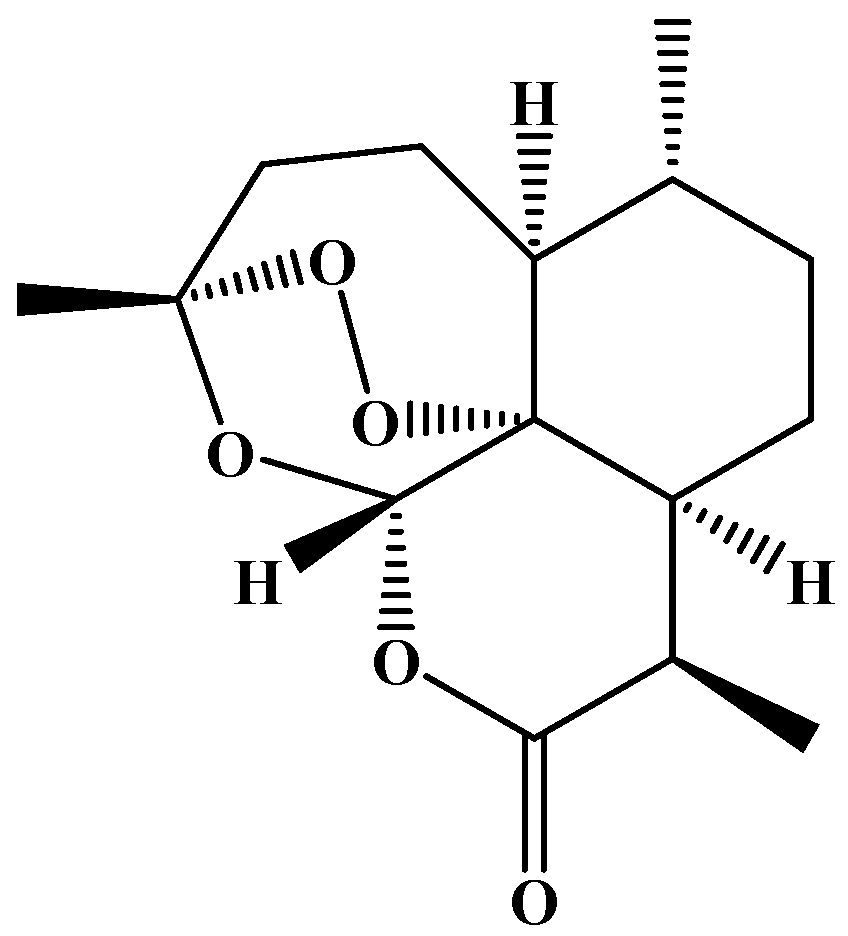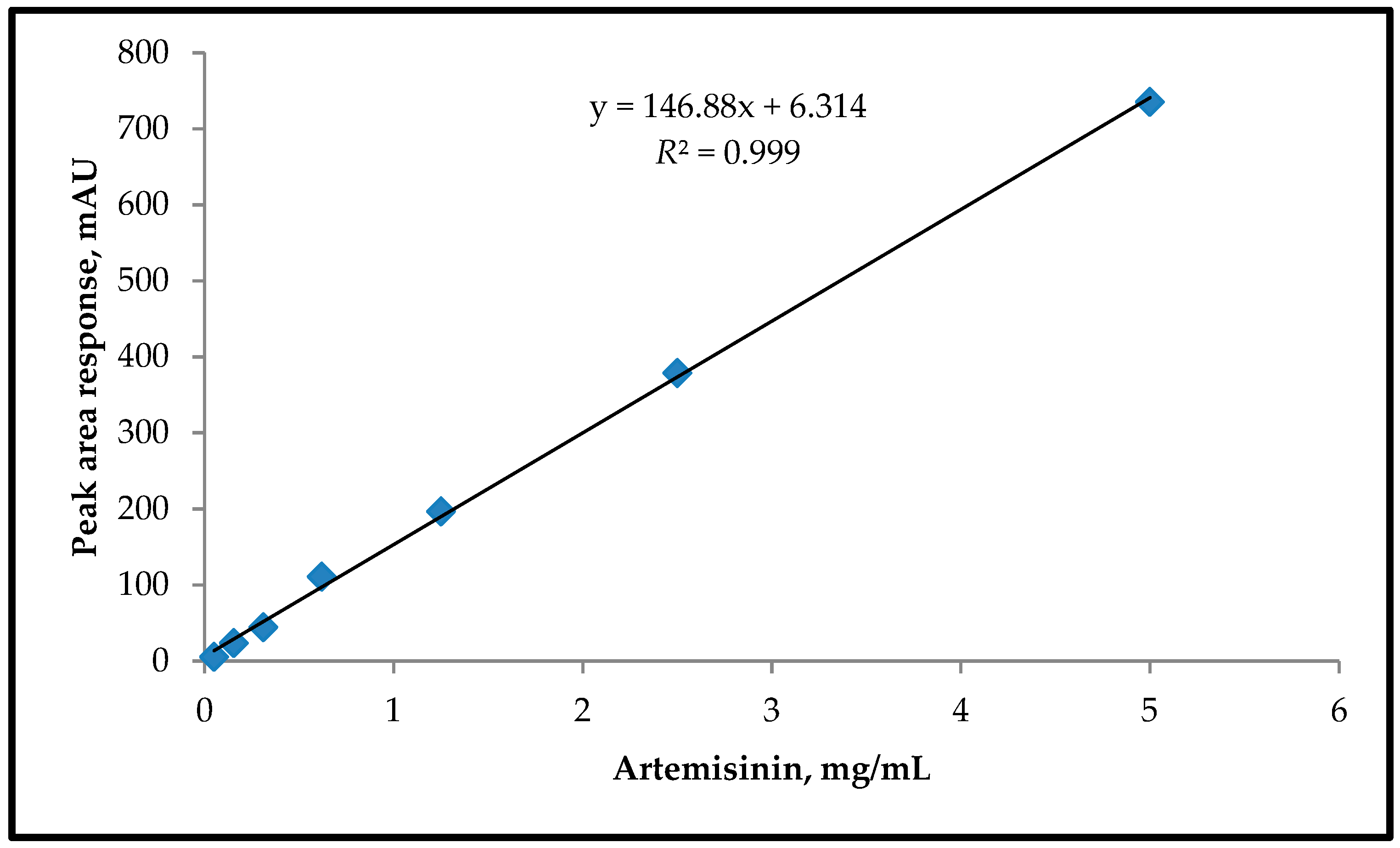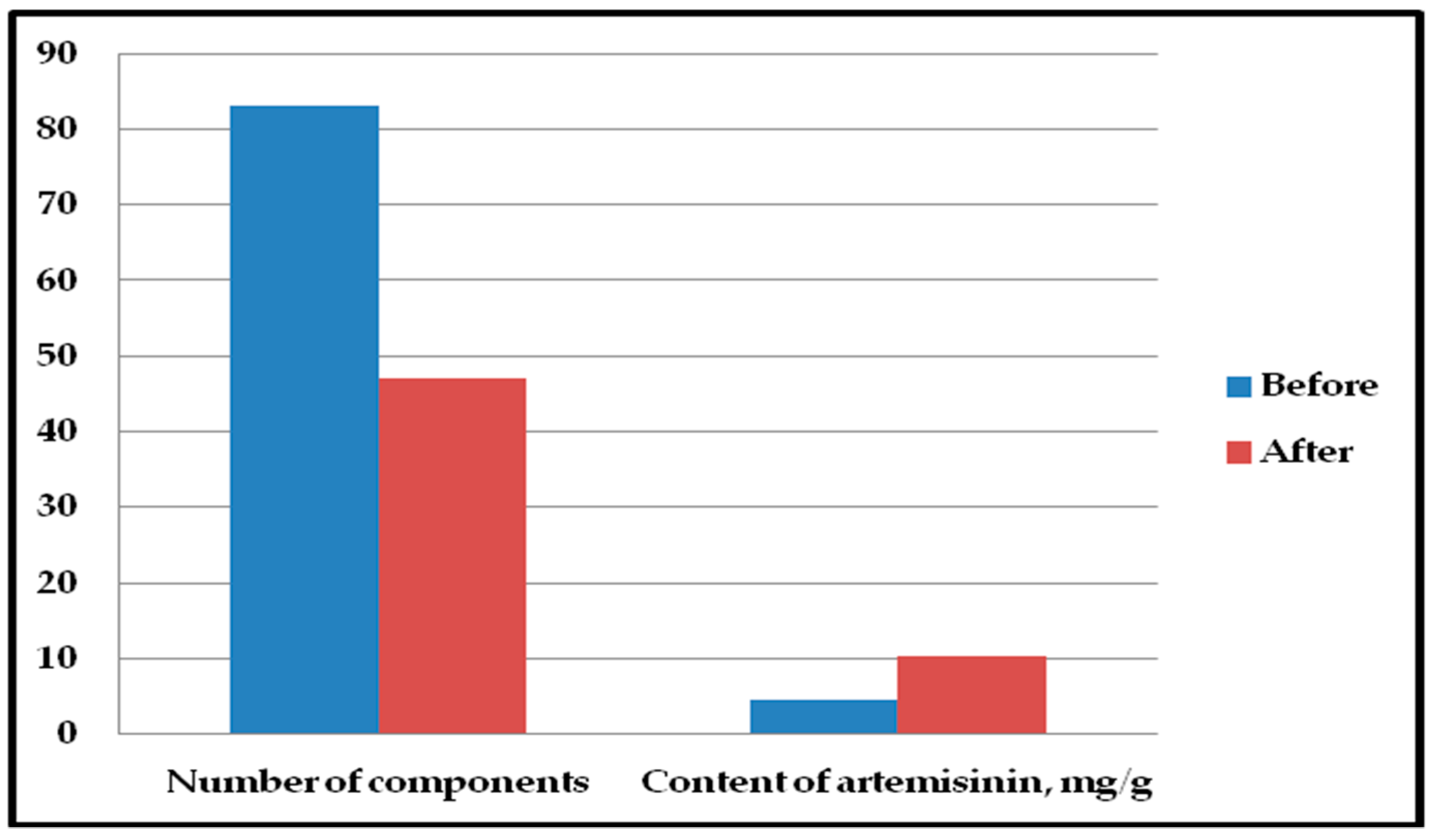Assessment of Artemisinin Contents in Selected Artemisia Species from Tajikistan (Central Asia)
Abstract
:1. Introduction
2. Materials and Methods
2.1. Plant Materials
2.2. Preparation of Hexane Extracts
2.3. Quantitative Analysis of Artemisinin Using HPLC
2.4. Purification of Artemisia annua Extract
3. Results
4. Discussion
5. Conclusions
Supplementary Materials
Author Contributions
Acknowledgments
Conflicts of Interest
References
- WHO. World Malaria Report 2018; WHO: Geneva, Switzerland, 2018; p. 165. [Google Scholar]
- Nosten, F.; White, N.J. Artemisinin-Based Combination Treatment of Falciparum Malaria. Am. J. Trop. Med. Hyg. 2007, 77, 181–192. [Google Scholar] [CrossRef] [PubMed]
- Guon, Z. Artemisinin anti-malarial drugs in china. Acta Pharm. Sin. B 2016, 6, 115–124. [Google Scholar]
- Sanz, M.; Vilatersana, R.; Hidalgo, O.; Garcia-Jacas, N.; Susanna, A.; Schneeweiss, G.M.; Valls, J. Molecular phylogeny and evolution of floral characters of Artemisia and Allies (Anthemideae, Asteracea): Evidence from nrdna ets and its sequences. Taxon 2008, 57, 66–78. [Google Scholar]
- Sharopov, F.; Setzer, W.N. Medicinal plants of Tajikistan. In Vegetation of Central Asia and Environs; Egamberdieva, D., Öztürk, M., Eds.; Springer Nature: Cham, Switzerland, 2018; pp. 163–210. [Google Scholar]
- Sharopov, F.S.; Sulaimonova, V.A.; Setzer, W.N. Composition of the essential oil of Artemisia absinthium from Tajikistan. Rec. Nat. Prod. 2012, 6, 127–134. [Google Scholar]
- Sharopov, F.S.; Setzer, W.N. Thujone-rich essential oils of Artemisia rutifolia stephan ex spreng. Growing wild in Tajikistan. J. Essent. Oil-Bear. Plants 2011, 14, 136–139. [Google Scholar] [CrossRef]
- Sharopov, F.S.; Setzer, W.N. The essential oil of Artemisia scoparia from Tajikistan is dominated by phenyldiacetylenes. Nat. Prod. Commun. 2011, 6, 119–122. [Google Scholar] [PubMed]
- Tan, R.X.; Zheng, W.F.; Tang, H.Q. Biologically active substances from the genus Artemisia. Planta Med. 1998, 64, 295–302. [Google Scholar] [CrossRef]
- Brown, G.D. The biosynthesis of artemisinin (qinghaosu) and the phytochemistry of Artemisia annua L. (qinghao). Molecules 2010, 15, 7603–7698. [Google Scholar] [CrossRef]
- Rydén, A.M.; Kayser, O. Chemistry, biosynthesis and biological activity of artemisinin and related natural peroxides. In Bioactive Heterocycles III; Springer: Berlin/Heidelberg, Germany, 2007; Volume 9, pp. 1–32. [Google Scholar]
- Yarnell, E. Artemisia annua (sweet annie), other Artemisia species, artemisinin, artemisinin derivatives, and malaria. J. Restor. Med. 2014, 3, 69–85. [Google Scholar] [CrossRef]
- Krishna, S.; Uhlemann, A.C.; Haynes, R.K. Artemisinins: Mechanisms of action and potential for resistance. Drug Resist. Updat. 2004, 7, 233–244. [Google Scholar] [CrossRef]
- Meshnick, S.R. Artemisinin: Mechanisms of action, resistance and toxicity. Int. J. Parasitol. 2002, 32, 1655–1660. [Google Scholar] [CrossRef]
- Arab, H.A.; Rahbari, S.; Rassouli, A.; Moslemi, M.H.; Khosravirad, F.D.A. Determination of artemisinin in Artemisia sieberi and anticoccidial effects of the plant extract in broiler chickens. Trop. Anim. Health Prod. 2006, 38, 497–503. [Google Scholar] [CrossRef] [PubMed]
- Aryanti; Bintang, M.; Ermayanti, T.M.; Mariska, I. Production of antileukemic agent in untransformed and transformed root cultures of Artemisia cina. Ann. Bogor. 2001, 8, 11–16. [Google Scholar]
- Mannan, A.; Ahmed, I.; Arshad, W.; Asim, M.F.; Qureshi, R.A.; Hussain, I.; Mirza, B. Survey of artemisinin production by diverse Artemisia species in northern Pakistan. Malar. J. 2010, 9, 310. [Google Scholar] [CrossRef] [PubMed]
- Mannan, A.; Ahmed, I.; Arshad, W.; Hussain, I.; Mirza, B. Effects of vegetative and flowering stages on the biosynthesis of artemisinin in Artemisia species. Arch. Pharm. Res. 2011, 34, 1657–1661. [Google Scholar] [CrossRef] [PubMed]
- Mannan, A.; Shaheen, N.; Arshad, W.; Qureshi, R.A.; Zia, M.; Mirza, B. Hairy roots induction and artemisinin analysis in Artemisia dubia and Artemisia indica. Afr. J. Biotechnol. 2008, 7, 3288–3292. [Google Scholar]
- Bayarmaa, J.; Zorzi, G.D. Determination of artemisinin content in Artemisia annua L. Mong. J. Boil. Sci. 2011, 9, 47–51. [Google Scholar]
- Hsu, E. The history of qing hao in the Chinese materia medica. Trans. R. Soc. Trop. Med. Hyg. 2006, 100, 505–508. [Google Scholar] [CrossRef] [PubMed]
- Ranjbar, M.; Naghavi, M.R.; Alizadeh, H.; Soltanloo, H. Expression of artemisinin biosynthesis genes in eight Artemisia species at three developmental stages. Ind. Crop. Prod. 2015, 76, 836–843. [Google Scholar] [CrossRef]
- Salehi, M.; Karimzadeh, G.; Naghavi, M.R.; Badi, H.N.; Monfared, S.R. Expression of artemisinin biosynthesis and trichome formation genes in five Artemisia species. Ind. Crop. Prod. 2018, 112, 130–140. [Google Scholar] [CrossRef]
- Zia, M.; Abdul, M.; Chaudhary, M.F. Effect of growth regulators and amino acids on artemisinin production in the callus of Artemisia absinthium. Pak. J. Bot. 2007, 39, 799–805. [Google Scholar]
- Charles, D.J.; Simon, J.E.; Wood, K.V.; Heinstein, P. Germplasm variation in artemisinin content of Artemisa annua using an alternative method of artemisinin analysis from crude plant extracts. J. Nat. Prod. 1990, 53, 157–160. [Google Scholar] [CrossRef]
- Dayrit, F.M. From Artemisia annua L. to Artemisinins: The Discovery and Development of Artemisinins and Antimalarial Agents; Academic Press: Cambridge, MA, USA, 2017. [Google Scholar]
- Singh, A.; Vishwakarma, R.A.; Husain, A. Evaluation of Artemisia annua strains for higher artemisinin production. Planta Med. 1988, 54, 475–477. [Google Scholar] [CrossRef]
- Woerdenbag, H.J.; Pras, N.; Chan, N.G. Artemisinin, related sesquiterpenes, and essential oil in Artemisia annua during a vegetation period in Vietnam. Planta Med. 1994, 60, 272–275. [Google Scholar] [CrossRef] [PubMed]
- Hamidi, F.; Karimzadeh, G.; Monfared, S.R.; Salehi, M. Assessment of Iranian endemic Artemisia khorassanica: Karyological, genome size, and gene expressions involved in artemisinin production. Turk. J. Boil. 2018, 42, 322–333. [Google Scholar] [CrossRef]
- Pellicera, J.; Saslis-Lagoudakis, C.H.; Carrió, E.; Ernst, M.; Garnatje, T.; Grace, O.M.; Gras, A.; Mumbrú, M.; Vallès, J.; Vitales, D.; et al. A phylogenetic road map to antimalarial Artemisia Species. J. Ethnopharmacol. 2018, 225, 1–9. [Google Scholar] [CrossRef] [PubMed]
- Suresh, J.; Singh, A.; Vasavi, A.; Ihsanullah, M.; Mary, S. Phytochemical and pharmacological properties of Artemisia pallens. Int. J. Pharm. Sci. Res. 2011, 5, 3090–3091. [Google Scholar]
- Singh, A.; Sarin, R. Artemisia scoparia: A new source of artemisinin. Bangladesh J. Pharmacol. 2010, 5, 17–20. [Google Scholar] [CrossRef]
- Liu, C.X. Discovery and development of artemisinin and related compounds. Chin. Herb. Med. 2017, 9, 101–114. [Google Scholar] [CrossRef]
- Kayani, W.K.; Kiani, B.H.; Dilshad, E.; Mirza, B. Biotechnological approaches for artemisinin production in Artemisia. World J. Microbiol. Biotechnol. 2018, 34, 54. [Google Scholar] [CrossRef]
- Zeng, Q.P.; Qiu, F.; Yuan, L. Production of artemisinin by genetically-modified microbes. Biotechnol. Lett. 2008, 30, 581–592. [Google Scholar] [CrossRef] [PubMed]
- Arsenault, P.R.; Wobbe, K.K.; Weathers, P.J. Recent advances in artemisinin production through heterologous expression. Curr. Med. Chem. 2008, 15, 2886. [Google Scholar] [CrossRef] [PubMed]
- Hommel, M. The future of artemisinins: Natural, synthetic or recombinant? J. Boil. 2008, 7, 38. [Google Scholar] [CrossRef] [PubMed]
- Badshah, S.L.; Ullah, A.; Ahmad, N.; Almarhoon, Z.M.; Mabkhot, Y. Increasing the strength and production of artemisinin and its derivatives. Molecules 2018, 23, 100. [Google Scholar] [CrossRef] [PubMed]
- Efferth, T. Artemisinin–second career as anticancer drug? World J. Tradit. Chin. Med. 2015, 1, 2–25. [Google Scholar] [CrossRef]
- Zhang, Y.; Xu, G.; Zhang, S.; Wang, D.; Prabha, P.S.; Zuo, Z. Antitumor research on artemisinin and its bioactive derivatives. Nat. Prod. Bioprospect. 2018. [Google Scholar] [CrossRef] [PubMed]
- Efferth, T. From ancient herb to modern drug: Artemisia annua and artemisinin for cancer therapy. Semin. Cancer Boil. 2017, 46, 65–83. [Google Scholar] [CrossRef]
- Naß, J.; Efferth, T. The activity of Artemisia spp. and their constituents against Trypanosomiasis. Phytomedicine 2018, 47, 184–191. [Google Scholar] [CrossRef]
- Yuan, D.S.; Chen, Y.P.; Tan, L.L.; Huang, S.Q.; Li, C.Q.; Wang, Q.; Zeng, Q.P. Artemisinin: A panacea eligible for unrestrictive use? Front. Pharmacol. 2017, 8, 737. [Google Scholar] [CrossRef]
- Ferreira, J.F.S.; Gonzalez, J.M. Analysis of underivatized artemisinin and related sesquiterpene lactones by high-performance liquid chromatography with ultraviolet detection. Phytochem. Anal. 2009, 20, 91–97. [Google Scholar] [CrossRef]
- Lapkin, A.A.; Walker, A.; Sullivan, N.; Khambay, B.; Mlambo, B.; Chemat, S. Development of HPLC Analytical Protocol for Artemisinin Quantification in Plant Materials and Extracts. J. Pharm. Biomed. Anal. 2009, 49, 908–915. [Google Scholar] [CrossRef] [PubMed]
- Paniwnyk, L.; Briars, R. Examining the extraction of artemisinin from Artemisia annua using ultrasound. In International Congress on Ultrasonics; Linde, B.B.J., Pączkowski, J., Ponikwicki, N., Eds.; American Institute of Physics: Gdańsk, Poland, 2011; pp. 581–585. [Google Scholar]
- Huter, M.J.; Schmidt, A.; Mestmäcker, F.; Sixt, M.; Strube, J. Systematic and model-assisted process design for the extraction and purification of frtemisinin from Artemisia annua L.—Part iv: Crystallization. Processes 2018, 6, 181. [Google Scholar] [CrossRef]
- Liu, C.Z.; Zhou, H.Y.; Zhao, Y. An effective method for fast determination of artemisinin in Artemisia annua L. by high performance liquid chromatography with evaporative light scattering detection. Anal. Chim. Acta 2007, 581, 298–302. [Google Scholar] [CrossRef] [PubMed]
- Peng, C.A.; Ferreira, J.F.S.; Wood, A.J. Direct analysis of artemisinin from Artemisia annua L. using high-performance liquid chromatography with evaporative light scattering detector, and gas chromatography with flame ionization detector. J. Chromatogr. A 2006, 1133, 254–258. [Google Scholar] [CrossRef] [PubMed]
- Waffo, A.F.T.; Yesildag, C.; Caserta, G.; Katz, S.; Zebger, I.; Lensen, M.C.; Wollenberger, U.; Scheller, F.W.; Altintas, Z. Fully electrochemical mip sensor for artemisinin. Sens. Actuators B. Chem. 2018, 275, 163–173. [Google Scholar] [CrossRef]
- Czechowski, T.; Larson, T.R.; Catania, T.M.; Harvey, D.; Wei, C.; Essome, M.; Brown, G.D.; Graham, I.A. Detailed phytochemical analysis of high- and low artemisinin-producing chemotypes of Artemisia annua. Front. Plant Sci 2018, 9, 641. [Google Scholar] [CrossRef]
- Liersch, R.; Soicke, H.; Stehr, C.; Tüllner, H.U. Formation of artemisinin in Artemisia annua during one vegetation period. Planta Med. 1986, 52, 387–390. [Google Scholar] [CrossRef] [PubMed]
- Patil, A.R.; Arora, J.S.; Gaikar, V.G. Purification of artemisinin from Artemisia annua extract by sorption on different ligand loaded polymeric adsorbents designed by molecular simulation. Sep. Sci. Technol. 2012, 47, 1156–1166. [Google Scholar] [CrossRef]
- Chemat-Djenni, Z.; Sakhri, A. Purification of artemisinin excerpt from Artemisia annua L. In MATEC; EDP Sciences: Les Ulis, France, 2013. [Google Scholar]



| Species | Local Name | Collection Site | Time | Voucher Number |
|---|---|---|---|---|
| A. annua | гoвҷoрӯб (govjorub), бурғун (burghun) | Ziddeh, Varzob Region | 15.07.2018 | CTICNPG 2018 - 5 |
| A. vachanica | пуши oддӣ (pushi oddi) | Khaskhorugh, Ishkoshim Region | 25.08.2018 | CTICNPG 2018 - 6 |
| A. vulgaris | cафедҷoрӯб (safedjorub), явшoн (yavshon) | Khaskhorugh, Ishkoshim Region | 22.08.2018 | CTICNPG 2018 - 7 |
| A. mackrocephala | пуши калoнгул (pushi kalongul) | Khaskhorugh, Ishkoshim Region | 21.08.2018 | CTICNPG 2018 - 8 |
| A. leucotricha | пуши сафед (pushi safed) | Khaskhorugh, Ishkoshim Region | 22.08.2018 | CTICNPG 2018 - 9 |
| A. dracunculus | тархун (tarkhun), ғӯда (ghuda) | Ziddeh, Varzob Region | 15.07.2018 | CTICNPG 2018 - 10 |
| A. absinthium | тaхач (takhach) | Guli Bodom, Yovon Region | 20.07.2018 | CTICNPG 2018 - 11 |
| A. scoparia | туғак (tughak), маҳинҷoрӯб (mahinjorub) | Guli Bodom, Yovon Region | 20.07.2018 | CTICNPG 2018 - 12 |
| Species | Yield of Hexane Extract, % | Number of Components | Content of Artemisinin in Dry Weight Plant, % |
|---|---|---|---|
| Artemisia annua | 5.80 ± 0.05 | 83 | 0.45 ± 0.03 |
| Artemisia vachanica | 8.09 ± 0.1 | 90 | 0.34 ± 0.02 |
| Artemisia vulgaris | 2.32 ± 0.02 | 95 | 0.18 ± 0.01 |
| Artemisia makrocephala | 3.01 ± 0.02 | 94 | 0.20 ± 0.01 |
| Artemisia leucotricha | 3.19 ± 0.03 | 75 | Not detected |
| Artemisia dracunculus | 3.78 ± 0.04 | 100 | 0.07 ± 0.01 |
| Artemisia absinthium | 5.41 ± 0.0.5 | 98 | 0.09 ± 0.01 |
| Artemisia scoparia | 3.39 ± 0.02 | 90 | 0.11 ± 0.02 |
| Artemisia Species | Part Used | Artemisinin, % | Ref. |
|---|---|---|---|
| A. absinthium | Flowers, leaves, stem, and roots | 0.02–0.35 | [17,22,24] |
| A. austriaca | Leaves | 0.05 | [23] |
| A. aff. tangutica | Flowers, leaves, stem, and roots | 0.02–0.11 | [17] |
| A. anethifolia | Leaves | 0.05 | [30] |
| A. anethoides | Leaves | 0.006 | [30] |
| A. annua | Flowers, leaves, stem, and roots | 0.02–1.4 | [17,25,26,27,28,51,52] |
| A. arborescens | Leaves | 0.001 | [30] |
| A. apiacea | Leaves | Not shown | [21] |
| A. bushriences | Flowers, leaves, stem, and roots | 0.01–0.34 | [17] |
| A. campestris | Leaves, buds, and flowers | 0.05–0.1 | [22] |
| A. cina | Shoots | 0.0006 | [16] |
| A. ciniformis | Leaves | 0.22 | [23] |
| A. deserti | Leaves | 0.4–0.6 | [23] |
| A. diffusa | Leaves, buds, and flowers | 0.05–0.15 | [22] |
| A. dracunculus | Flowers, leaves, stem, and roots | 0.01–0.27 | [17] |
| A. dubia | Flowers, leaves, stem, and roots | 0.01–0.07 | [17,19] |
| A. incana | Leaves | 0.25 | [23] |
| A. indica | Flowers, leaves, stem, and roots | 0.01–0.10 | [17,19] |
| A. fragrans | Leaves | 0.2 | [23] |
| A. frigida | Leaves | 0.007 | [30] |
| A. gmelinii | Leaves | 0.038 | [30] |
| A. japonica | Flowers, leaves, stem, and roots | 0.01–0.08 | [17] |
| A. kopetdaghensis | Leaves | 0.18 | [23] |
| A. integrifolia | Leaves | 0.036 | [30] |
| A. lancea | Leaves | Not shown | [21] |
| A. macrocephala | Leaves | 0.011 | [30] |
| A. marschalliana | Leaves | 0.38 | [23] |
| A. messerschmidtiana | Leaves | 0.032 | [30] |
| A. moorcroftiana | Flowers, leaves, stem, and roots | 0.01–0.16 | [17] |
| A. parviflora | Flowers, leaves, stem, and roots | 0.03–0.15 | [17] |
| A. pallens | Leaves and flowers | 0.1 | [31] |
| A. roxburghiana | Flowers, leaves, stem, and roots | 0.02–0.22 | [17] |
| A. scoparia | Leaves, buds, and flowers | 0.1–0.18 | [22,32] |
| A. sieberi | Aerial parts | 0.1–0.2 | [22,23] |
| A. sieversiana | Flowers, leaves, stem, and roots | 0.05–0.20 | [17] |
| A. spicigeria | Leaves, buds, and flowers | 0.05–0.14 | [22] |
| A. thuscula (syn. A. canariensis) | Leaves | 0.045 | [30] |
| A. tridentata Nutt. subsp. vaseyana | Leaves | 0.0005 | [30] |
| A. vestita | Flowers, leaves, stem, and roots | 0.04–0.20 | [17] |
| A. vulgaris | Flowers, leaves, stem, and roots | 0.02–0.18 | [17,22] |
© 2019 by the authors. Licensee MDPI, Basel, Switzerland. This article is an open access article distributed under the terms and conditions of the Creative Commons Attribution (CC BY) license (http://creativecommons.org/licenses/by/4.0/).
Share and Cite
Numonov, S.; Sharopov, F.; Salimov, A.; Sukhrobov, P.; Atolikshoeva, S.; Safarzoda, R.; Habasi, M.; Aisa, H.A. Assessment of Artemisinin Contents in Selected Artemisia Species from Tajikistan (Central Asia). Medicines 2019, 6, 23. https://doi.org/10.3390/medicines6010023
Numonov S, Sharopov F, Salimov A, Sukhrobov P, Atolikshoeva S, Safarzoda R, Habasi M, Aisa HA. Assessment of Artemisinin Contents in Selected Artemisia Species from Tajikistan (Central Asia). Medicines. 2019; 6(1):23. https://doi.org/10.3390/medicines6010023
Chicago/Turabian StyleNumonov, Sodik, Farukh Sharopov, Aminjon Salimov, Parviz Sukhrobov, Sunbula Atolikshoeva, Ramazon Safarzoda, Maidina Habasi, and Haji Akber Aisa. 2019. "Assessment of Artemisinin Contents in Selected Artemisia Species from Tajikistan (Central Asia)" Medicines 6, no. 1: 23. https://doi.org/10.3390/medicines6010023
APA StyleNumonov, S., Sharopov, F., Salimov, A., Sukhrobov, P., Atolikshoeva, S., Safarzoda, R., Habasi, M., & Aisa, H. A. (2019). Assessment of Artemisinin Contents in Selected Artemisia Species from Tajikistan (Central Asia). Medicines, 6(1), 23. https://doi.org/10.3390/medicines6010023








